Jeff Grubb's Blog, page 23
May 30, 2021
Plague Books: Sharpe's Image
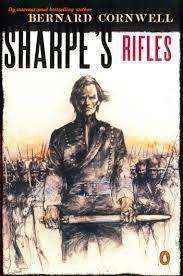 Sharp's Rifles by Bernard Cornwell, Penguin Books, 1988
Sharp's Rifles by Bernard Cornwell, Penguin Books, 1988Provenance: Purchased at the Page Turner in downtown Kent. During my sojourn of selling off my comics collection, I swore that I would make no purchases until I had sent all the comics off. However, with the last group I took some store credit, and splurged on a number of volumes, including some Ellison, Derleth, Forester, Fraser, and some of the Sharpe's series.
Review: I really liked Patrick O'Brian's Aubrey and Maturin sea novels, which dealt with the age of fighting sail during the Napoleonic Wars. So I was looking for something of the similar era and had heard about the BBC production of this series. No, I didn't watch the series, but I picked up a volume or three. This is purportedly the first, from the number on the spine, but really is the ninth published and the sixth chronologically in the series (The protagonist had before we meet him here had been in India and at Trafalgar).
So, not really the first book in the series, or the first book written, but the first book of the Spanish campaigns. So a lot of this is backstory setting up the character. Anyway, how is Richard Sharpe?
Not that good. A solider-of-the-line rifleman who was promoted to Captain for heroism (from previous/later books) and squirreled away as Quartermaster for his unit on the Iberian Peninsula to resist the invading forces of Napoleon Bonaparte. Other officers don't like him because he is not a "real" officer - from the Upper Classes. Those he commands don't like him for the same reason - they believe officers are born, not made. So he's pretty miserable. Then the superior officers are wiped out, and it is up to Sharpe to lead his recalcitrant men to something resembling safety. In the middle of this, he gets involved with a Spanish Nobleman who is carrying a mysterious treasure, who is being pursued by his own posse of enemies.
Sharpe is not great at his job. He knows more than most of his superiors about tactical combat, but is out-thought and out-maneuvered by his enemies and his supposed allies alike. His main asset is a bulldog determination and battlefield cunning that makes him grit his teeth and get the bloody job done.
What Cornwell does well is both setting up his battle plans and showing how they quickly disintegrate upon contact with the enemy. His battles are described in sand-table accuracy, and the results of combat in grande guigol goriness. He captured the smoke from the pans of the rifles and the screams of the horses.
By the same token, his writing tends to tell as opposed to show (you want to know what they mean by this, take a look here), particularly with internal characterization. We are taken into Sharpe's head with long reflections and recriminations. And sometimes we are bounced out into another characters' head to share something that is not fully revealed from other characters, which is a bit frustrating as well. In combat, Cornwell pulls it all together.
There is also an element of fantasy here that would almost fit in Greyhawk or the Realms. Sharpe's supposed Spanish ally, Blas Vivar, is on a quest to take a holy relic to a city held by the French, to raise it in a church with a ceremony to rally the people of Spain against Napoleon. This entire plot pitches the gritty reality of the Peninsular campaign towards high fantasy, and while Sharpe doubts, he goes along with it. As a result, he gets played by Blas Vivar multiple times.
What can you say about Sharpe at this point? Well, he's got room to grow, though the multitude of books before and after this indicates that it may be a low learning curve. The writing is solid, and I have a couple more volumes on the shelf. But I think I will try a few other things first.
More later,
May 23, 2021
Plague Books: TED Talks in Text
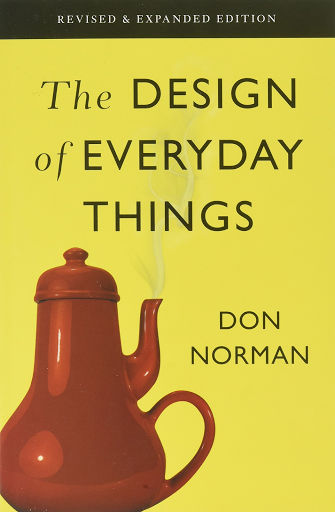 The Design of Everyday Things by Don Norman, Revised and Expanded Edition, Basic Books, 2013
The Design of Everyday Things by Don Norman, Revised and Expanded Edition, Basic Books, 2013Provenance: I was part of a online seminar a while back, and one of the other participants, Brannon Boren, recommended this book strongly. Picked it up via Amazon, and soon discovered that it was a bit of a Bible among those engaging in games design, in particular UX (User eXperience) and UI (User Interface).
Review: Even before this book, I was sensitized to UX/UI, due to my job. In part, an Amazon goal is to make processes (ordering stuff, playing games, watching a video) as frictionless as possible, and I am as a result aware of every bump, hiccup, and obstacle on the net and in real life that gets in my way. Just as an example, I am calling out those self-checkout kiosks at the grocery store, which are so bunged up they require live employees to stand by to help out us troglodytes who flail away at them.
But trogs we are not, says Norman - it is primarily the fault of bad design, that does not take into account how people actually use the things they use,communicate with them easily, and can handle when the user does not do the expected thing. And this book is filled with examples of bad design, good design, and evolving design, and the challenges that one faces when trying to create utility for objects that will be used by people who are not in the same room as you, and whom you cannot yell at ("No, turn the knob to the right. Clockwise! No, the OTHER clockwise!").
And this is familiar territory. You've hit things that don't work the way they should - doors that look like they push when they pull. Knobs that don't map directly to the burners on the stoves. Light switches that are not even in the same room as the lights they control (I have a LOT of these in our house, much to the frustration to guests who walk into a darkened bathroom and don't realize the light switch is Back Out in the Hall). The book has a lot of examples, and Norman returns to them several times to push various points through the text.
The book itself is written in bite-sized, readable bits, and is better for reading over a section, considering it for a while, then moving on to the next. IDeal if, say, you're commuting on a public transport. Or between meetings. Or, well, in the bathroom. This is (I have to admit) where the bulk of my consumption of the book took place. It is like a bunch of short videos distilled down into a readable bite-sized form.
And it has a lot of organizational buckets for its ideas - The Seven Stages of Action. The Five Whys. The Three Levels of Processing. Yes, they sound like competing Martial Arts Schools, but Norman makes they all explainable and how they all fit in together. Indeed, he has the bits that look they evolved neatly into the "Flywheel" process that Amazon and other companies have adopting for product development and adequately using feedback loops.
And he lays out Norman's Law, which summarized, says "As soon as a project starts, it is behind schedule and over budget". Because I've been there, too.
Does he get everything right? Not completely. He uses his own book's organization as an example of text that can be read in any order, because non-fiction is different in fiction in that it is not yoked to a narrative through-line. However even nonfiction has a narrative flow in that it is making an argument and building its conclusions on previously presented material. You go immediately to the back of the book for answers, and you miss out on the logic that gets you there.
 The Picturephone - 1970.
The Picturephone - 1970. Yes, I was alive at that time.Also, amusingly, he sites as a example the continuing failure of the videophone, which showed up at the end of the 18th Century as a concept for long-distance communication, and continued to never take hold up through the 21st Century (There was an ad for the videophone that was shot in Pittsburgh, and they wheeled it out whenever they were pushing the idea). Of course, in the past year, that entire concept has blown up not by a dedicated device, but by the fact that everyone HAD to teleconference, and with it, the rules changed and suddenly people were zooming/chiming/discording/tiktokking and what have you, even though this expanded volume came out less than a decade ago.
However, in general I am looking at a great little book that is easily consumable, and packs a punch on design issues, and I will strongly recommend it for everyone in "da bizniss", as it was recommended to me. Go forth and be sensitized on the issues.
More later,
May 18, 2021
Plague Books: Kafka-esque
Provenance: Lent to my by Stan!
Review: Fretwell is an author on that most burdensome of writer's tasks, the Book Tour. He goes from store to store on a fruitless quest to make personal appearances (that no one cares about), meet his public (who don't show up), and sell his books (which do not sell). The suitcase containing his books have been stolen, his publisher is ghosting him, and his wife is nothing more than a distant voice on the telephone.
Oh, and he's a suspected serial killer.
The Book Tour is a graphic novel by Andi Watson which moves leisurely through its absurd urban landscape. Watson's style is quiet, and his dialogue short and filled with assumptions on both parties' parts. Fretwell wanders through an ornate, deeply illustrated city filled with self-involved, minimalist characters, most of whom are so wrapped up with their own lives to the point that Fretwell does not register, much less matter. And Fretwell himself takes it all without losing his cool or pressing his own advantage.
Fretwell's hell is Kafkaesque. I got that feeling from the very name of his doomed book - "Without K", as K was the last name of victim in Kafka's "The Trial". And like The Trial, Fretwell comes under suspicion of a crime he did not commit, and confronts a universe that is not maliciously uncaring in a Lovecraftian sense, but uncaring in its own right.
Stan! tells me he took his time with the book, and I can see why - in addition to being an author, Stan! is a cartoonist, and the pacing of the story as Fretwell moves from encounter to encounter is excellent, his characters frustratingly obtuse, and his city is both malignant and detailed. I on the other hand, moved through it slowly because it raised a lot of my dark ghosts of my own previous book appearances, ranging from the ones where no one showed up, to those where we violated some local idiosyncrasy, to those when we were literally in the shadow of better-known authors (as in, right beneath a banner that says "Meet Tom Clancy!". Every writer has those experiences - buy me a beer and I'll bend your ear, but this book unearthed them in all their undead glory.
But back to the book. Watson's universe is uncaring, but not in a malicious way, but rather just self-absorbed. Fretwell is a irritant to the inhabitants of that world, and his relentless desire to push on through his adversities (which quickly pile up) forms the hub of the story. I think I know who the serial killer is, or at least, who I want the serial killer to be.
In the end, this a post-war British black comedy, something produced by Eaton Studios with Alec Guiness as Fretwell, directed by that young Hitchcock fellow who had already left for Hollywood. And that's a movie I would be glad to see.
More later,
May 16, 2021
Life in the Time of the Virus: Signs of Life
 Morning Sun by Edward Hopper - 1952 It's not over. Not yet. But it feels like there is a long, group, exhalation from holding your breath for too long a time.
Morning Sun by Edward Hopper - 1952 It's not over. Not yet. But it feels like there is a long, group, exhalation from holding your breath for too long a time.The good news is that fatalities are down in the Seattle area, and cases and hospitalizations have leveled off. A recent map of the region put the vacc rate at 70% for at least one shot, the vaccine is plentiful, and a lot of sites are taking walk-ins. But we are still seeing new cases, particularly among younger people. I haven't seen a precise reason yet, but I wonder if it is connected in any way with the re-start of in-person schools. Of course, this was a thought that occurred to me as I was driving over to Covington Labs for a blood draw, and found myself behind multiple school buses.
The rest of the world continues to pitch and yaw with the disease. India at one time was so untouched that people strained to come up with reasons why. Now it is being hit hard. Russia was under reporting its damage, which is of little surprise. Brazil remains a dumpster fire, and Sweden, who banked on herd immunity, has suffered worse than its Scandinavian neighbors. Island nations keep a tight watch on their borders. And our own official national count may be low as well, and the "real" number of deaths may be up to twice of what we reported.
On a more regional level, the governors are taking it on the chin, red or blue, for a) doing too much, b) not doing enough, or c) doing both at the same time. And even though I am wary of returning to "business as previous", I have to admit we have seen improvements. But improvements are not eradication.
But the CDC has gone on record in the past week on pulling off the masks, and though they bunker it in cautious, adult terms (IF you are vaccinated and IF you are outside), it seems like the reaction is as if Landru suddenly shouted "Festival!" (Original Star Trek reference, for the younger kids). Will we see a bigger fourth wave moving forward, or are enough folk vacced to give us a fighting chance?
At the personal level, the local groceries are still masked up, and I'm good with that, and I will continue to wear masks when indoors in public, and likely when I am outdoors in among strangers as well. My personal favorite mask has a purple octopus on it, and people assume that I am supporting Seattle's nascent hockey team. Our Pandemic Pod has resumed outdoor meetings when the weather is good, all of us grabbing various forms of takeout and camping in the backyard. The Lovely Bride has gotten a brazier for fires, and Housemate Anne has a mosquito-repeller she says will keep the Washington State Bird at bay. The pair have been renovating the garden with surprising speed as the LB emerges from tax hell.
And my company has been putting things together to return people to the office in some form. A lot of my former project-comrades have moved on to other things, but I still have my desk in the office (though last time I was there I had forgotten what floor we were on). And much of Queen Anne Hill and Lake Union are blocked by newer buildings that have gone up in the interim. I did manage to save an overstuffed chair that I call "The Story Chair", where people would come by and our team would talk about story with them. A lot about his (and many other things) is still unknown and unrevealed, but we are moving forward to some semblance of the before-times.
More later,
April 26, 2021
Comics: End of the Collection
Those who know me may be in for a bit of a shock: I have gotten rid of my comic book collection.

To call it a collection would be rounding up. It is more of an accumulation, forty-plus years of paper and staples that had been acquired, read and deposited in long white coffins, to rest in state in various locations. Most recently that location was a small room billed optimistically by the realtor as a Mother-In-Law apartment (When my Mom-In-Law stayed with us, she got the guest room - much nicer). When we first moved to Seattle, the Lovely Bride built a storage rack for the collection, four bins wide and two bins high, each bin holding 9 "long-boxes" of comics, each long-box about 30" long and holding about 300 comics easily (or 350 the way I would jam them in). So that is, what, 72 long boxes with a total of about 2.5k comics.
I read comics as a kid. Harvey comics like Sad Sack and Hot Stuff the Little Devil. I read DC comics, which were better than Marvels because you could never guarantee you would get the "next issue" at the drug store, never mind that a sizable chunk of the DCs were reprints from the early fifties. Original works included Dial H for Heroes and Legion of Superheroes and Superman's Pal Jimmy Olsen. I think I had the first issue of Luke Cage, Hero for Hire.
Then I stopped, showing a preference for MAD magazine as my drug store read. The old comics, disposable culture, were disposed.
In college I got back into comics. I blame the Star Wars comic and Howard the Duck. The guy in the next room over at the dorm read super-hero comics (Hi, Joe!) and I started reading the Fantastic Four and Iron Man. The story about creating a superhero RPG from alL this can be found here. I stored the comics in the bottom drawer of my dresser in the dorm, and brought them home in grocery bags.
Out of college, I started picking up books regularly, and started storing them in "real" long-boxes. In Pittsburgh, the only direct-sale shop was on the North Side, Eide's, in the an area where urban renewal had not gotten around to renewing yet. There I found the Small Press Indies - Elfquest, Cerebus, and the like. The boxes started to pile up. When I had gotten them to about 3 by 3, I put a sheet of plywood over them and made them into a desk. The boxes were not bleached white yet, and while I was bagging I was not boarding them (and never would).
 The story of how Marvel Super Heroes came about at TSR is here (again) But the upshot was not only was I using my collection as a resource, Marvel was now sending me comics on a weekly basis. I got on their mailing list and got two copies of everything. One copy went into manila folders and was circulated around the office (for "research" purposes) while my own copy went home. We were now storing the comics in an attic crawlspace over the kitchen. The LB and I would drive up to Milwaukee to the Turning Page every other week on a Friday (then comic-book day), then go to Chi-Chi's at the mall for Mexican food (table for two, good light source, please). Eventually I went for weekly runs to Rockhead's in Kenosha, and finally a pair of fans started carrying comics at their video store/gas station in Lake Geneva.
The story of how Marvel Super Heroes came about at TSR is here (again) But the upshot was not only was I using my collection as a resource, Marvel was now sending me comics on a weekly basis. I got on their mailing list and got two copies of everything. One copy went into manila folders and was circulated around the office (for "research" purposes) while my own copy went home. We were now storing the comics in an attic crawlspace over the kitchen. The LB and I would drive up to Milwaukee to the Turning Page every other week on a Friday (then comic-book day), then go to Chi-Chi's at the mall for Mexican food (table for two, good light source, please). Eventually I went for weekly runs to Rockhead's in Kenosha, and finally a pair of fans started carrying comics at their video store/gas station in Lake Geneva.About that time I was writing comics for DC (Story here) and got on THEIR mailing list, so I got a lot of comics coming in. And in the process of all this I got a lot of comics that I would never buy, like Barbie, and movie adaptations like Richie Rich and comics for Kiss, Alice Cooper, and Prince. And I got a lot of exposure to their full lines - Vertigo and Epic and Milestone. Some was very good, some was forgettable. I made a culling and got rid of four boxes at a shop up in Madison.
I no longer am on those mailing lists, but the accumulation continued. The brown boxes became large white boxes. I stopped bagging, and eventually I stopped sorting, instead just stacking. The boxes became time capsules, layered like strata of popular culture. I brought the collection to Seattle, and the LB built the storage bins. I filled up about half of them, but over the years they filled up, and there were a couple extra white coffins on the floor as well. The boxes got wider (to accommodate the backing boards I don't use), and the paper stock for comics has gotten heavier and glossier. A box of old newsprint was about 50 pounds, one stuffed with recent books was more like 70. Soon, I would not be able to move them again. They became a wall of paper, and I considered that, in case of a nuclear attack, I could build a fallout shelter with them. Viking funeral also came to mind.
And so it was time to get rid of them. Needed the space, and the necessity of keeping them for research had diminished - not only was I not designing RPGs, but a lot of the material was available through trade paperback reprints and online. And the fictional universes have rebooted multiple times, with a surge of destructive fury replaced by a flurry of number ones, so their usefulness as historical records was diminished.
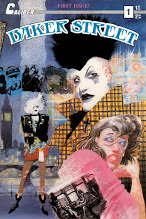 And I went through them all in the process of cleaning them out. Some we kept - Kate had some we wanted to keep - Starstruck from Epic and Jonny Quest from Comico and Power Pack from Marvel and the underappreciated Baker Street from Caliber (punk Sherlock Holmes). I kept Astro City (Various publishers), Planetary, Groo the Wanderer, and the various Handbooks, Who's Whos, and Secret Files. And multiple all the stuff I worked on over the years, with the exception of a backup story for a TSR comic that set up the story and then was cancelled that issue.Going through them was like an archaeological dig. Newsprint gave way to glossy stock throughout. There were flurries of relaunched and renumbered Number Ones. There were stunts like chrome covers and embossed covers and wordless issues and sideways printing, and even a couple three-D's. There were books that I don't even remember reading - Xombi and Ravage 2099 and Hokum & Hex and Leonard Nimoy's PriMortals. Sublines like Razorwire and Heavy Hitters. And most recently mega-epics that swallowed entire company lines with huge epic storylines.
And I went through them all in the process of cleaning them out. Some we kept - Kate had some we wanted to keep - Starstruck from Epic and Jonny Quest from Comico and Power Pack from Marvel and the underappreciated Baker Street from Caliber (punk Sherlock Holmes). I kept Astro City (Various publishers), Planetary, Groo the Wanderer, and the various Handbooks, Who's Whos, and Secret Files. And multiple all the stuff I worked on over the years, with the exception of a backup story for a TSR comic that set up the story and then was cancelled that issue.Going through them was like an archaeological dig. Newsprint gave way to glossy stock throughout. There were flurries of relaunched and renumbered Number Ones. There were stunts like chrome covers and embossed covers and wordless issues and sideways printing, and even a couple three-D's. There were books that I don't even remember reading - Xombi and Ravage 2099 and Hokum & Hex and Leonard Nimoy's PriMortals. Sublines like Razorwire and Heavy Hitters. And most recently mega-epics that swallowed entire company lines with huge epic storylines.And I'm done. Those we did not keep I took down, four and five boxes at a time, to the Page Turner, a thriving used bookstore in Kent, Washington (Online it can be found as Hasberts.com). The store has an excellent collection of comics, genre fiction, histories, and pop culture. I pulled out the black and white indies (which the store owner said didn't sell well for him) for a friend (and stored them in brown paper grocery bags). The last load went down this weekend, in celebration of Seattle's Independent Bookstore Day/Week. So far I haven't had a shred of seller's regret. Now the bins are stacked with plastic containers filled with sewing projects and old paperwork belonging to my late mother-in-law.
I still read comics, but I doubt I will be hoarding them. Maybe it is time to look at electronic formats (which, oddly enough, may make the print comics of today more valuable in that there will be fewer of them, much like the paper drives of WWII boosted the disposal of old golden age books). It does feel like I have jettisoned almost two tons of albatross from my life.
Now I just need to figure out what to do with all these National Geographics.
More later,
April 22, 2021
Plague Books: Clap for the Wolfe, Man
 Too Many Cooks/ Champagne for One by Rex Stout. Bantam Books, 2009 reprint of novels from 1938 and 1958.
Too Many Cooks/ Champagne for One by Rex Stout. Bantam Books, 2009 reprint of novels from 1938 and 1958.Provenance: Purchased at the Strand, New York City, in the before times. I had gone to the Strand to look for the new Will Gibson book, but they had sold out. But I did find this one.
Recently, I bogged down with three rather involved tomes, so when I went in for my shot, I took this book along. Didn't really need it, but once started, I spent several pleasant spring afternoons on the back deck reading it.
Review: This is a reprint compilation - two books, twenty years apart, shoved together under a single set of covers. No additional editing, and it shows. The first book runs its course, and the second begins with new page numbering. The fonts and leading are different in both halves. There's a big globby typo on page 104 of the first story that is still there. So the effort on the 2009 reprint consists of new covers and printing.
What it does do is that it allows us to compare two books, same author, same characters, same general setup, twenty years apart and eighty years back in time. Yes, there is some creakiness involved, but in general, they hold up.
(OK, for those who haven't heard me talk about this before, here's the overview of the series: Nero Wolfe is a brilliant, overweight, cantankerous private detective with a superiority complex and preference for fine food, orchids, and not working. Archie Goodwin is his legman. employee, and friend, the wisecracking Watson in this pair, but more social and more street savvy. He pushes, goads, and otherwise manipulates Wolfe into doing the right thing as part of his job. Together they're detectives.)
So, Too Many Cooks. Here Wolfe is out of his element. He is going to a gathering of professional chefs in West Virginia to give an after-dinner speech and enjoy the food, and maybe get a secret recipe from one of the chefs. One of the chefs present is one of those guys who everyone says deserves to be stabbed. Yeah, he is stabbed. So, large crowd of suspects, Wolfe having to do things he does not want to do, Archie is being charming and flirtatious, but with a heart of gold. Even at this early date, a lot of the components of a Nero Wolfe story are pretty much set in stone.
An interesting exception deals with race. Up to this point, I hadn't considered how white Wolfe's world is, but in this case a major set of witnesses at the resort in W Va are black men. Despite being set in New York, a lot of the people who Wolfe is dealing with are Caucasian. Some of that is dealing with the Upper Class, his clients, but also most of the day-to-day that Archie runs around with - cabbies and doormen and receptionists. There is a variety of European heritages - Italians and Irish and Polish and French, and Wolfe himself is Serbian. But these would fall under the ancient rubric of "White Ethnic", a phrase I don't think I've heard since 1978 (Its flipside would be WASP - equally extinct in the modern age, even with a recent failed attempt to resurrect it as simply "Anglo-Saxon")).
But we are in West Virginia for this tale, and black men are the resort staff. They cook and serve the food. They hold the doors. The help. They are made semi-invisible by the shade of their flesh. How does Stout handle it? Casual N-bombs are thrown in the text, but not by Archie or Nero, though Archie does use a few archaic epithets that I had to look up. When confronting the staff as potential witnesses to the crime, Wolfe delivers a "Brotherhood of Man" speech that borders on cringe-worthy to modern ears, but Wolfe pulls it off in part because of his own insufferable superiority to everyone regardless of race or creed. And Stout's characterizations of the African-American staff are better than most films of the era, and he makes clear why the staff would be unwilling to cooperate with the white establishment, regardless of where in Europe those ancestors came from.
Champagne for One also involves a hot topic of its time - in this case unwed mothers. Up to the mid-70s, there were "schools" that would take pregnant unwed mothers in, see them to term, provide varying levels of support and putting the children up for adoption. The lessening of stigma about teenage pregnancy did a lot to reduce their popularity and the rise of birth control, but they are at the heart of this part of the mystery.
The setup for this one is a bit stilted, but bear with me. Widow of the founder of one of these homes continues her late husband's tradition of inviting three of the women from the school (post-birth) and three young men (of upper middle class) to a dinner at her mansion. At this particular one, Archie is leaned upon to fill in as one of the young men. One of the women, who had told people she kept poison in her purse in case she decides to do herself in, is poisoned. Everyone assumes it is suicide, but Archie goes on record as saying it is murder. And that eventually brings Wolfe in.
And here, twenty years later, the formula is firing on all cylinders. We have the brownstone on West 35th street. We have the supporting cast, both household and professional. We have the cigar-chomping chief of detectives, who lives in the pantheon with Piroit's Inspector Japp and Holmes Lestrade as foils and frenemies. We have the big cast of upper-class suspects, who pack their own secrets and agendas. That last is definitely a Stout trademark - the murder is not frozen in amber, but rather the players continue to conspire and plot as Wolfe closes in. But the setting and action is comfortable, right down to the red chair in Wolfe's office. Are these "cozy mysteries", a term used for rural sleuths like Miss Marples? Yeah, I can see it. Comfort food with a little murder on the side.
I guessed the murderer in the first book, but not the exact method. Was surprised by the murderer in the second even though I caught the fatal statement that led to the reveal. Not that I claim to be up to Wolfe or Goodwin's level.
More later,
April 19, 2021
Life in the Time of the Virus - Not Throwing Away My ... Shot.
 Doctors Looking At Art
Doctors Looking At Art from John Hopkins Magazine And so I am vaccinated. The Johnson & Johnson "one and done" vaccine.
It happened a couple weeks back, on a Wednesday. It turns out that the process of making appointments was tougher than the process of getting the stab itself. Being JUST under 65 in Washington State meant I missed out on the initial round, but when we finally cleared at the end of the month April, both the Lovely Bride and I when to the vaccine finder online and, finding out that shots would be given out at the local hospital, Valley Med. Great. Except to sign up, you went to the UWMed site, and once you signed up to be put on the waiting list, there was no confirmation one way or another.
So after a week I went back to the vaccine finder, and signed up for a bunch of locations. I found they were giving the vaccine at the local sports complex (the ShoWare center, a local venue noted for never turning a profit every year). But by the time I filled out all the forms, they were out of appointments. So I ended up signing up down for a vaccination site down in Auburn, at the Outlet Center (formerly known as the Supermall). And filled out the online forms pretty fast to keep from losing THAT one.
Now, because of what I do (designing computer games), I am extremely sensitized to UX (user experience) - how people navigate the complex web of their online experience. Every site had their own format, their own questions, and their own process. and for anyone who was not computer-savvy, it was a frustrating experience (The Lovely B, by the way, got on her iPad during a Zoom dinner party, and struck a win very quickly with a local Rite-Aide, which did not have any openings when I went looking four days before - BUT since then the J&J vaccine was halted as a result of potential blood clotting, so she's been moved further back in the line).
So, the Supermall. A friend had had a horrible experience locating the vaccination site, so I went down early for the first appointment of the day. The web site gave the location of the site by the Suite number of the store, but the maps of the mall itself did not identify anything by Suite number. And there was not a lot of signage in the mall parking lot (Supermall - big parking lot on all four sides). parked near by best guess, and found that the mall ITSELF was closed at that hour. I drove to where I had seen a number of cars parked thinking it was another entrance. And indeed, THAT was the site where the vaccine was being distributed. Spoilers: It was on the north side of the building, with a HUGE white tent for people to queue up in.
It might have been the hour, or the fact I was there early (9:30, even after going to the wrong entrance), or the fact that the web sites had confused so many people, but the huge white tent was empty, and I walked in. The place (an abandoned Sports Authority with an external main door) was swarming with helpful volunteers in orange jackets (far outnumbering the patients). One asked me if I had brought along my ID and QRCode from the confirmation message. I had not brought the QRCode, and she sent me to Guest Services, which was a long set of tables with more volunteers. I was the first of the day, so the young woman that was helping me had an older volunteer at her side, and four more volunteers hanging over her shoulder to understand what needed to be done. It turned out the first volunteer at the door was wrong - you did not NEED to bring along your QRCode, it just makes it easier. I was confirmed and sent on my way to the long, empty queue area leading to the shots itself. It was sort of like arriving for your flight early, and No One was ahead of you at security.
And here's the thing - everyone was extremely friendly and upbeat, something I rarely see in malls these days, so I was actually taken aback. The friendly volunteer at the empty queue directed me to a table with two more friendly volunteers (trainee and trainer) who took my information, and when I confirmed I had an allergy (sulfa drugs), called over a friendly firefighter who said there should be no problem but I should wait 15 minutes after the shot to be sure, and another friendly firefighter administered the shot. Now, I have an INTENSE dislike of needles, but this was probably the easiest shot I've ever gotten. I was sent to another friendly volunteer who was stationed near a widely spaced set of chair, and when I did not fall out said chair in 15 minutes, I was released into the (closed) mall itself, where a string of friendly volunteers in orange jackets showed me to the exit.
I had taken the rest of the day off (because I was topping out my vacation time in any event), so I ran some more errands and went home, and napped. Felt a little "meh" the next day, but avoided any serious reaction.
So, it's over? No, it is not. First off two weeks to have the vaccine run its course. Plus, in D&D terms, the vaccine is Damage Resistance, not Damage Immunity. I am not immune to fire, but I will take less damage from the fire, hopefully to the point where, if I suddenly find myself in a fireball, I would not be hospitalized.(I will refrain from torturing this analogy any further in the name of the Geneva Convention). The end result is that I will continue to use a mask when I go out, and work from home until the situation changes further.
In the outside world things are trying to lurch back to normal, with a rise in number of cases in several counties out here, but a decline in fatalities (A separation of the sick and the dead). King County is verging on slipping back to Stage 2 from Stage 3. Traffic is starting to suck again, more people are being shot in public places, and I'm getting a lot more spam calls. So, I guess America is slowly becoming America again. The local grocery has pulled up the one-way arrows for the aisles that everyone was ignoring anyway. The local newspaper did a long piece on Sunday on museums that were slowly and cautiously reopening. There was an article as well about how, despite expectations, there was a decline in suicides in the past year, as people did not deal with each other as much. And there remains much concern about new variants that are spreading and replacing earlier waves.
So we have hit a milestone (instead of a millstone), and there is some glimmer of light at the end of the tunnel. On the 15th the floodgates open, and everyone else will be allowed to get the vaccine (which, to continue the airport analogy, feels like when they have boarded the first class, business, gold, platinum, jade, and radioactive metals classes, along with people with children, those who are serving/have served in the military, and Seahawk fans, and now are ready to board "All Other Rows".
And that is where a lot of my younger colleagues are: All Other Rows. This too, I want to say, will pass.
More later,
March 18, 2021
Life in the Time of Virus - The New Year
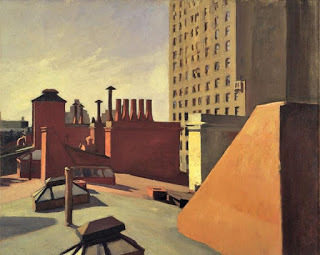 City Roofs by Hopper, 1932
City Roofs by Hopper, 1932A year ago, my company sent everyone home. It was thought at the time it might be a few weeks, then a few months, then by Fall at the latest.
And now it may be by early Fall of this year, and even then it may be only for a few days a week just to keep touch in the flesh.
I've been back in the office a few times since then, and it still looked a bit like the Mary Celeste. Our department were in the process of reshuffling our desks around when the word came down, so some desks are empty, some have boxes, and some still have everything on them as if the occupant had just stepped away. Looking out the windows, I can see new skyscrapers that been erected while we've been gone, further blocking the view of Lake Union.
I haven't gotten my vaccine yet, though not through a lack of desire. Each state has its own schedule and rules, and, alas, I am neither old enough or nor sick enough or nor vital enough to get priority. And, to be honest, I don't want to jump the queue to get a shot when there are people who ARE old enough, sick enough, or vital enough still waiting for the situation.
However, every report I get from family and friends says that when it DOES become available, and one figures out how to get it, the entire process is well-run and fairly painless (painless compared to coming down with the coronavirus). So I have something to look forward to.
The numbers continue to climb, though a lower rate than the winter highs. But also climbing has been the number of doses administered. At the time of this writing, there have been 29 million cases in the US, and 538,000 deaths. But 113 million doses of vaccine have been administered and that number is climbing rapidly.
In the meantime, the dawn has begun to claw its way back from utter darkness. Seattle is the northernmost major city on the continental US, further north than the bulk of the population of Canada. So the winter darkness hits us hard. Back in the beforetimes I was used to watching the dawn from an upper floor of a Seattle skyscraper. So working at home has had that advantage, but I follow the sun - the earlier it rises, the earlier I will be at work.
There is the other social distancing going on right now up here - this one involving birds. Due to wildfires, we have an "irruption" of pine siskins. Now while "pine siskins" sounds like a snack food, it a small, mostly-Canadian bird that is now is hanging about in large numbers in the Puget Sound region. This sudden overpopulation is called an irruption, and would not be a big deal, except that they are currently carrying a deadly form of salmonellosis . So birds need to socially distance. Which means that we can't use the bird feeder in the back yard until the beginning of April. Maybe longer. Yeah, I know how the birds feel.
And we have housemates up here on Grubb Street. Some friends were having housing issues, a situation made more serious by one of them having to undergo chemotherapy up in Seattle. So they have joined us, and we have been doing a lot of cleaning and moving things about, as well as adjusting to other peoples' rhythms in the house. Part of this has been to encourage the Lovely Bride and I to do some projects we have been meaning to do for some time, like strip out the carpeting in the guest room or (slowly) dispense with a lot of my comic collection in the basement. (OK, it is no longer a collection, it is an mere accumulation - if you're looking for something in particular, I am sending it all to Page Turner Books down in Kent - good store, check it out).
But as a result of all this, my time usually spent screwing around has been diminished, and there are things that still need to be done all around me. Sort of a spring cleaning on overdrive.
It will still be a couple months before I can spend the evenings on the back deck with a good book and a strong drink, but I am working towards it. In the meantime, I remain confined to quarters, wearing a mask on the rare times when I do go out, and generally bearing up.
More later,
March 11, 2021
Plague Book: In the Blood
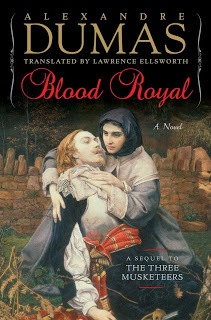 Blood Royal, or, The Son of Milady by Alexandre Dumas, Edited and Translated by Lawrence Ellsworth, Pegasus Books, 2020
Blood Royal, or, The Son of Milady by Alexandre Dumas, Edited and Translated by Lawrence Ellsworth, Pegasus Books, 2020Provenance: Christmas book, 2020
Review: These books have quickly become mental comfort food. I had read an excellent translation of the Three Musketeers long ago and far away, but fell into the Ellsworth translations with the Red Sphinx and kept coming back. Ellsworth is better known in gaming circles as Lawrence Schick (D&D module S2 - White Plume Mountain, among other things), and his spirit of adventure carries through here in his translation.
This volume is the back half of the original publication of Twenty Years After, which originally appeared as a serialized novel. In it, Dumas deals with two different civil wars - one in France called the Fronde, and the English Civil War. In the first half, the four inseparables are separated through loyalties and responsibilities, Mordaunt, the son of Milady plots his revenge, and two of the group (Aramis and Athos) debark for England to help King Charles, on the ropes from Cromwell's revolution.
We pick up this volume with D'Artagnan and Porthos also heading for England, with instructions to help Cromwell and assigned to aid Mordaunt, who plots all of their demises. They soon switch sides and work to save King Charles (noble but doomed), who had been betrayed to Cromwell's forces.
And here's the thing: they have to fail (spoilers). Historically, Charles was beheaded (real spoilers), and while Dumas will be kinda fast and loose with the facts and timelines to suit his fiction, he cannot keep the King of England alive. So we have a long section where the crafty Gascon (D'Artagnan is given that sobriquet a number of time) comes up with a plan that just ALMOST works, before time or fate or the presence of the Son of Milady foils it at the last moment. Mordaunt pops in a number of times,and the crew also fails to dispatch him, and ultimately the group has to flee England in a boat rigged with explosives.
Back in France, the four split up, and D'Artagnan and Porthos are imprisoned by the current evil cardinal (Mazarin, not the ruthless but effective Richelieu) for trying to save the English King. Athos and Aramis witness the machinations to overturn the revolutionary Frondeurs by splitting off its various factions, but rescue D'Artagnan and Porthos, and get enough leverage to get what they themselves ultimately want (which is not what the revolutionaries were after). It all ends in a riot, much as it began in the previous volume.
D'Artagnan is no longer an innocent, but is crafty and the man with the plan throughout this book. Porthos lusts after his peerage and respect, and is the most broadly-fashioned of the group. Aramis is the Sexy Priest, only moreso. Athos has in my brain changed over the passing of 20 years - the fact that he has a son (who will be more important later) has made him more of a worrier and fretter, both on behalf of his son and in general. That son in turn sort of vanishes in this volume, after a good start in the previous volume.
The swashbuckling is hard and heavy, ranging from battlefield maneuvers to very D&Dish duels, and in one section, a dungeon exploration. Dumas reserves his sharpest tongue for the politicians of all shapes and factions. Queen Anne of France is sleeping with Cardinal Maturan, who is more comic and less capable than his predecessor Richleau. The upper class leaders of the Frondeur are easily bought off by the Monarchy. The former valets of the Musketeers have established themselves with the greater society, to a variety of effects. All have their moments, but the center of the action are on the four musketeers.
Yeah, I'm bought in on that. There are three more volumes to come, which make up the Vicomte of Braelonne series, which ends in The Man in the Iron Mask. Yeah, I'm going to be there for them.
More later,
March 8, 2021
Plague Book: Mansions of the Mind
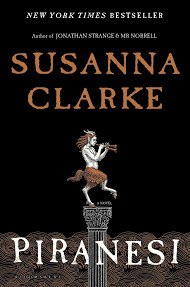 Piranesi by Susanna Clarke, Bloombury, 2020
Piranesi by Susanna Clarke, Bloombury, 2020Provenance: A Christmas book. I listened to the audio version of Clarke's previous novel, Jonathan Strange & Mr Norrell, and knew I wanted to read this one. So when it turned up among the usual suspects (NPR, The Seattle Times book page, the New Yorker), I asked the Lovely Bride for it as a Christmas present.
Review: Piranesi (not his real name, but what he is called), is a simple soul living in a mazework House, which is flooded by the sea. He lives on fish and seaweed. He maps the rooms and tends to the dead bodies he has found there. He does errands for the only other living person there, who he knows as the Other, who is acerbic and looking for the Secret Knowledge hidden in the maze. The House is made of white marble, its halls populated by titanic statues, and it floods on a semi-regular basis from swelling tides.
Is the House real? Or are we trapped inside Piranesi's brain? Are we looking at a demiplane, or at dementia? Mansion or madness? The story unfolds effortlessly and captures a completely likeable and totally unreliable narrator. This is one of those books where you figure things out long in advance of the protagonist, and you are still surprised. You like Piranesi so much that any possible resolution to his situation feels like it will be heartbreaking, but Clarke manages to navigate the shoals of emotion neatly and gives you a satisfying conclusion his tale.
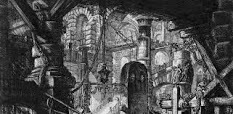 Prisons of the Imagination
Prisons of the Imagination I wiki'd up Piranesi, since the name itself meant nothing to me and there was no obvious reason for it presented in the text (there is a reason in-text, but you have to think about it). Giovanni Battista Piranesi was an archeologist, architect and artist who is best remembered for his black and white etchings of ancient ruins and wild, phantasmal vaults and prisons. Knowing this gave me another, but exact view, of what was going on Piranesi's world. Ultimately exactly what is going on in this fantastic landsacpe is theorized but not entirely defined, and that leaves it magical in its own right.
But let me talk briefly about the book as artifact.. There seems to be a new trope in book packaging regarding "serious" fantasy books - matte black covers with metallic ink. We saw it over on Circe and here it is again - Embossed lettering, copper ink, singular image, and a lot of empty black space. And hey, there's a blurb on the back cover from Circe's author. Though it is from a different publisher, it does feel like it is same design house. And it sends its own messages about the contents (This is "serious" fantasy). Authors do not always select their covers (and often do not have a say it such matters), but yes, if I were to deliver some "serious" fantasy, I would go for black and copper as well.
More later,
Jeff Grubb's Blog
- Jeff Grubb's profile
- 191 followers



